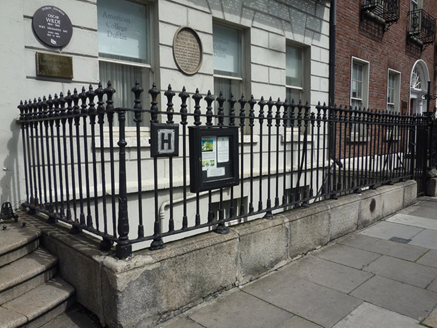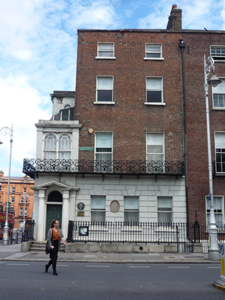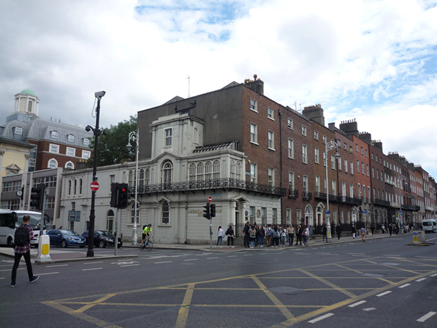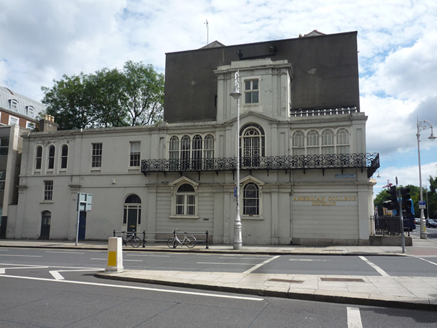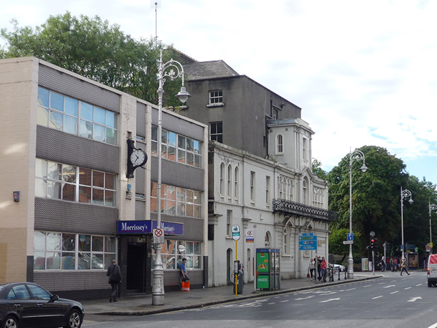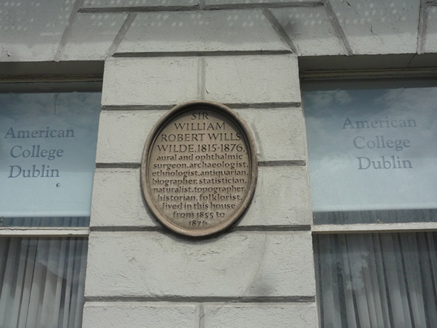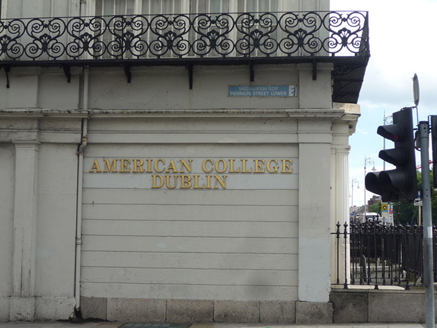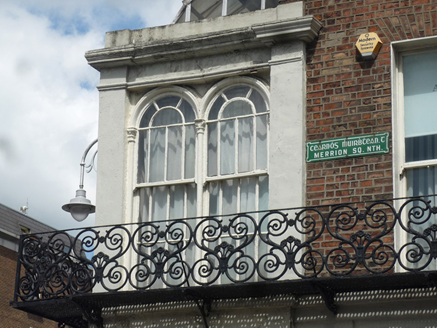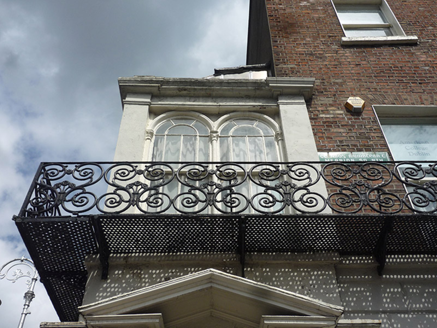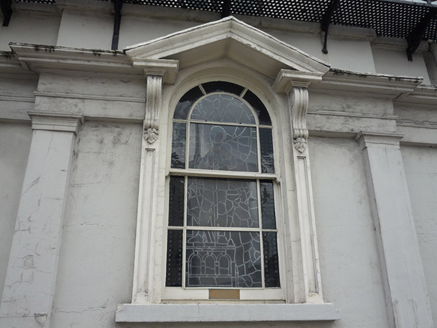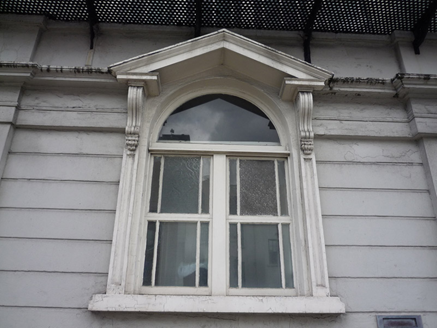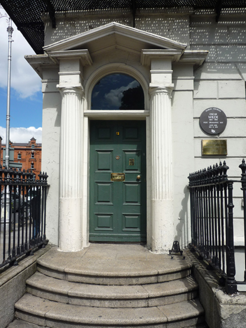Survey Data
Reg No
50100348
Rating
Regional
Categories of Special Interest
Architectural, Artistic, Cultural, Historical
Original Use
House
In Use As
College
Date
1760 - 1860
Coordinates
316584, 233728
Date Recorded
29/07/2016
Date Updated
--/--/--
Description
Corner-sited two-bay four-storey former house over basement, built 1762-5, having entrance block of 1859 to west end of facade that presents single bay to Merrion Square and three bays to Merrion Street Upper; this block has three-storey middle bay with shallow breakfront and flat roof, flanked by two-storey units. West elevation continued by further three-bay two-storey block. M-profile slate roof parallel to front elevation having smaller roof to middle, all hipped to west end, with partly rebuilt Flemish bond brown brick parapet with granite coping, brown brick chimneystack to east with clay pots, concealed gutters and replacement cast-iron downpipes. Later blocks have flat roofs throughout, except for front-most section with glazed half-Mansard roof, all having rendered parapet over moulded stringcourse, and rendered chimneystack to north gable end with clay pots. Flemish bond brown brick walls to upper floors of front facade of original block, over painted channelled rusticated walling to ground floor, with painted granite plinth, painted ruled-and-lined rendered walling to basement, and unpainted render to visible parts of rear and west elevations. Later block has rendered walling, with channelled rustication to ground floor of end bays of front block and smooth rendered walling elsewhere. Bays of entrance block defined by panelled pilasters to first floor over plain pilasters to ground floor on granite plinth course, with moulded stringcourse incorporating capitals of lower pilasters. Rear block defined by three plain full-height pilasters with stringcourse below first floor sill level and second stringcourse at ground floor capital level to front half of this block. Breakfront has plain pilasters to lower floors with plain entablature and moulded cornices, and top floor is flanked by paired pilasters having garlands to frieze, with moulded cornice to rendered set-back parapet with pediment device to centre. Square-headed window openings to upper floors of original block, diminishing in height, with painted rendered reveals, painted granite sills, with one-over-one pane timber sliding sash windows to upper floors of front elevation, timber casements to basement, latter with wrought-iron grilles, three-over-three pane to top floor of rear and west elevations, and six-over-six pane to at least first floor of rear elevation of main block and east elevation of return. Continuous ornate cast-iron balcony to first floor, extending to whole of symmetrical part of side elevation. Entrance block has round-headed windows to first floor, paired to front elevation and in groups of four to west and flanking central large window, pairs and groups being margined two-over-four pane timber sliding sash windows with colonnettes to mullions and continuous sill course, and segmental-headed middle-bay window being fixed double-light with stained glass and moulded render surround. Window to top floor is pseudo-three-centred with lugged render surround with panelled apron and timber casement window; pedimented window openings to north and middle bay of ground floor, with panelled render pilasters and fluted consoles supporting open-bed pediments and having painted masonry sills, with margined two-over-two horizontal pane stained-glass window to middle bay and fixed double-light window to north bay. Rear block has square-headed six-over-six pane timber sliding sash windows to first floor of front bays and mid-level of north bay and trio of round-headed one-over-one pane timber sliding sash windows to first floor of north bay, all with masonry sills and first floor openings having recessed aprons. Elliptical-headed principal entrance doorcase comprising two-thirds fluted Doric columns with entablature supporting open-bed pediment, and having plain fanlight, torus-moulded architrave, eight-panel painted timber door with brass door furniture, onto front of shallow breakfront with similar entablature. Granite platform to entrance, with three curved granite steps, cast-iron boot-scrape, and having decorative cast-iron railings over moulded granite plinth wall enclosing basement area. Wall plaques read "OSCAR WILDE 1854-1900 POET, DRAMATIST, WIT lived here 1855 to 1878" and "SIR WILLIAM WILLS WILDE, 1815-1876, aural and ophthalmic surgeon, archaeologist, ethnologist, antiquarian, biographer, statistician, naturalist, topographer, historian, folklorist, lived in this house from 1855 to 1876". Two doorways to west elevation, that in rear block being segmental-headed with glazed timber panelled door and plain fanlight and that to entrance block being round-headed with timber panelled doors, glazed sidelights and plain fanlight. Interior noted by Casey (2005) to have stairs transverse to plan, and fine Rococo cornices.
Appraisal
Nos. 1-3 Merrion Square were built by John Wilson for Thomas Keating and differ from many other buildings on the same side by lacking granite facing. In 1859 a stuccoed rear extension was added by Isaac and William Farrell to house a balconied first floor conservatory and the consulting rooms of the ophthalmic surgeon William Wilde and his wife Speranza, who moved here in 1855, when their son, Oscar, the writer and playwright, was an infant. It makes a strong architectural and aesthetic contribution to the early character of Merrion Square. The channel-rusticated ground floor makes the building distinctive and further decorative interest is provided by the doorway and the elegant metal balcony that continues around the side elevation. The first floor side elevation has windows grouped in a similar fashion to that of No. 85 Merrion Square, diagonally opposite. The variety of windows and treatments of openings adds interest to the facades. Laid out as part of the Fitzwilliam Estate, Merrion Square is one of the best-preserved Georgian streetscapes in Ireland. The north, east and south sides of the square are lined with terraced houses of eighteenth and nineteenth-century date, while the west side is terminated by the garden front of Leinster House. The terraced houses maintain a relatively uniform building height and design, attributed to standards promoted in Fitzwilliam's leases. Individuality was introduced through the design of doorcases, ironwork and interior decorative schemes. Outside 1 Merrion Square was where James Joyce (1882-1941) and Nora Barnacle (1884-1951) met for their first "date" (16th June 1904): the date of the "date" was later immortalised in Joyce's "Ulysses" (1922).
